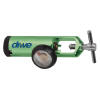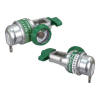Video on Oxygen Regulators
https://www.youtube.com/watch?v=GoluRtEyCus&feature=emb_title
Drive 870 Oxygen Regulator
 53.03 Cost
53.03 Cost
Drive 870 Oxygen Regulator
This regulator is to be used with M2, M6, ML6, B, C, D, E Cylinders.
For patients on continuous oxygen therapy, oxygen conserving devices (OCD) is a great option. These devices regulate the flow of oxygen between the patient and the oxygen cylinder. Factual information states that a person inhales 1:3 times and exhales 2:3 of the time. That means 2:3 of the oxygen gets wasted while the patient exhales. To control this wastage conserving devices are helpful. OCDs greatly increase the time for which an oxygen reservoir can be used i.e. it will last for three times more than the cylinder without the device.
Benefits of using Oxygen Conserving Device
- OCDs provide for increase mobility and comfort as it avoids the continuous flow of oxygen into the nostrils, thereby making oxygen therapy less intrusive and effective.
- People with chronic diseases like Cancer, cardiopulmonary diseases or COPD can choose to travel with smaller tanks compared to multiple tanks in the past without OCDs
- OCDs reduce the frequency of refills and deliveries. The cylinders now last as long as 3-5 times the normal.
- If in any case the Conserving device fails to work, it will switch to continuous flow.
With OCDs you can conserve a handsome amount of oxygen so there will be a lesser need for refill. Hence buying an OCD is more economical and less wasteful.
Types of Oxygen Conserving Devices:
Fixed Pulse OCDs
These devices
initiate when a person takes a breath. The fixed pulse concentrators
release a fixed volume of oxygen when initiated and stops at a preset
limit. The flow rate is high in the initial period that permits the
released volume to be delivered in the initial phase of inhalation. The
volume of oxygen released vary by manufacturers and the specific
devices. These devices are intended to produce a rate of oxygen flow
similar to continuous flow. The rate of flow varies from 5 ml to 22 ml
per setting per breath.
Demand-pulse OCDs
These devices are also breath initiated but post-delivery of the initial volume of oxygen these OCDs continue to deliver a fixed rate of oxygen i.e. 2 liters/minute, until exhalation depending on the manufacturer. Some devices have a diminishing flow rate until the valve closes stopping the flow completely. The oxygen delivered in the last one third part of the breath is considered to be wasted as it falls in the anatomical dead space of the breath.
Oxygen Conserving Devices or Flow control regulators are reduce the pressure and are designed to regulate or lower oxygen pressure coming directly from an oxygen cylinder to a level that can be safely used by the patient. Browse our catalogue to find the device that best suits your requirement and be assured to get a product that delivers quality and value both at the same time.
What Are Oxygen Regulators
Unlike oxygen conserving devices, oxygen regulators have flow control valves that help regulate the flow of oxygen depending on the dosage of the user. Oxygen conserving devices work automatically to alter flow, whereas regulators need to be physically calibrated to set the flow of oxygen. This makes oxygen regulators cheaper than oxygen conserving devices.Benefits of Oxygen Regulators
- Oxygen regulators help achieve maximum conservation efficiency in terms of physical calibration
- They come with a powerful flow control and bumper protected contents gauge
- They come in color coded options to allow for greater understanding of the flow and regulation of oxygen
- They are compact and lightweight and hence are easy to attach and use
Precision
Medical EasyPulse5+6 Oxygen Conserving Regulator

Cost 368.18
Precision Medical EasyPulse5+6 Oxygen Conserving Regulator has 6 continuous flow settings, to compliment the 1 thru 5 pulse settings. Even with the added continuous flow settings, it weighs in at a mere 9.9 oz and is only 4.75 inches long, making it still the smallest and lightest conserving regulator available. With the conserving ratio of up to 5.7 to 1, you enjoy the same great savings you have always enjoyed with the EasyPulse5.
Why choose Easypulse5 6 Oxygen Conserving Regulator?
- Big Results in a Small Package
- Reduces Deliveries
- CMV Technology
Easy Pulse5 Features
- Precision Medical EasyPulse5+6 Oxygen
Conserving Regulator delivers a front loaded tapered waveform
- CMV
Technology:
- All the oxygen is delivered in the first third of the inspiratory phase. With the added security of more continuous flow options, you have the most versatile oxygen conserving device available
-
Certifications:
- It meets or exceeds the requirements of the Medical Device Directive(MDD), Council Directive 93/42/EEC Concerning Medical Devices, Directive 2007/47/EC of The European Parliament and Council and all applicable design and safety related standards